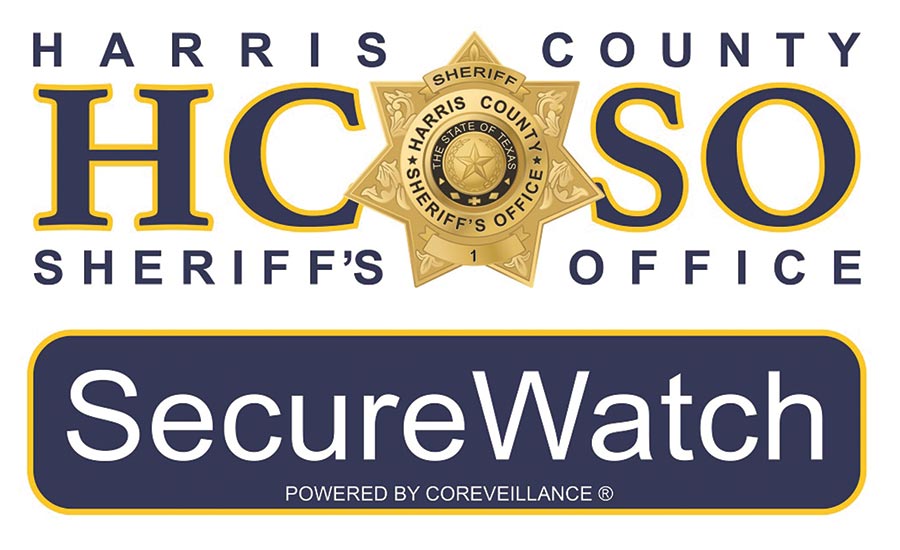Video Monitoring in the Sights of Guard Companies and Their Clients
How can remote guarding and video surveillance help security directors to go to sleep with complete peace of mind?

The Harris County Sheriff’s Office is attempting to lower crime by partnering with residents and businesses to gain access to their security cameras.
Photo courtesy of The Harris County Sheriff’s Office.

The HCSO Secure Watch is a free program that was introduced about four years ago and is powered by Corveillance — a cloud-based video surveillance company. The program went live on September 16, 2019.


Whether they are servicing commercial office buildings, college campuses, brick-and-mortar retail, healthcare facilities or other types of locations, security officer services companies and the clients who employ them are trying their best to keep on top of quickly evolving video monitoring technology. They want to figure out on a continuous basis how video monitoring can help keep their businesses secure, particularly in remote locations or at odd times of the week when a lone worker – or no human at all – is on patrol.
“Technology is a huge player in that space,” says Sean Meehan, director of sales and marketing at United Security, Inc. “And clients are always coming to our operations people, and the question they ask us is, ‘What type of technology solutions can you offer us that can assist with and improve upon the officer solution that you’re providing, at a reduced cost?’ ”
USI responded by creating an internal security integration division named USI Integrated Security Services more than five years ago to work with clients and help them explore how to integrate various types of technology, including cameras, access control and intrusion monitoring, Meehan says. “We do a lot of camera work at a large selection of our client sites,” he says. “The combination – the handoff between security officer staff and good technology—it’s rare when you don’t see that today. It is hand-in-hand. That’s where this division has gone.”
To monitor lone-worker security officers and assure clients they are making their appointed rounds as promised, USI has employed a technology called Trackforce that places poker-sized chips strategically throughout a building, with an app loaded onto a smartphone that “communicates” with those chips.
The officer logs onto the smartphone at the beginning of their shift, which provides updated post-orders for the officer to address, tracking of their routes and locations throughout the shift, and enables them to create threshold incident reports with photo or video uploaded to clients in real-time, Meehan says.
"In years past, a client would call up and say, ‘How do I know what the security officer is doing overnight?’ ” Meehan says. “We have a record of every single tab they have hit with the smart phone. And if there are ever any incidents – they’re patrolling at 2 a.m. and see water on the floor somewhere, which actually happened – the security officer is immediately able to do an incident report, in real time, and send it to a predetermined list of clients, and the chain of command at USI.”
Advances in Resolution, Mobility and Durability
The focus on video monitoring has tightened as technology has improved and clients have become ever-more cost-conscious, Meehan says. USI works with a variety of vendors depending on clients and their needs. “How do we integrate the right DVR with the right access system? How do we make sure they talk to each other?” he says. “In the older days, a building owner or a property manager would look at a property and say, ‘We need ‘X’ number of hours to staff this building.’ Putting cameras strategically throughout the building, we have been able to limit those hours per week of where a security officer has to be.”
Whether they are placed in a warehouse, or the far end of a parking lot, security officer can review and monitor an area remotely and more efficiently, Meehan says. “We train our security officers so they can manipulate footage of something that may happen. That’s huge for us,” he says. “Obviously, there’s an investment from the customer to install systems like that, but it’s a long-term return-on-investment (ROI). They’re able to lower operational spending through use of capital purchases to achieve an ROI and use those savings for other client or security needs.”
The resolution, mobility and durability of cameras have all improved dramatically over the years, making them a much more reliable tool, Meehan says. “We see lots of clients going for higher-end, four megapixel or five megapixel cameras, which can zoom in and get clear definition of what they’re looking at,” he says. “In addition, pan-tilt-zoom cameras, depending on the client, provide flexibility where, I can have a security officer at a [remote] station, and they can manipulate the camera to zoom in on a site and see things that are happening in real-time.”
In the not-too-distant past, there wasn’t much difference in durability between indoor and outdoor cameras, Meehan adds, which sometimes led to outdoor cameras succumbing to the elements. “Weather could rip them apart,” he says. “There’s been a lot more focus on the construction of those cameras. The outdoor cameras are built much better, and provide a better solution.”
Recordings from cameras have become easier to access and search, Meehan says. Where cameras used to record 24/7, some of the more advanced models only record an area when they sense movement, saving critical storage space. And those recordings can be uploaded and stored in a cloud-based server.
“Those are solutions that are a little bit leaner because we don’t need to install a special server onsite for the recordings and maintain that space,” he says. “We’re able to go in there with a little bit more well-rounded approach. It’s where this industry is going – smart, effective, useful technology as well as security officers who are trained on that technology.”
Keeping Eyes on Parking Lots, Warehouses
The Lowe’s Home Improvement big-box chain has been employing leading-edge video monitoring from LiveView Technologies with remote surveillance from Protos Security to keep eyes on its retail parking lots both during the day and after hours, says John Doggette, director of asset protection operations.
“It’s not in all of our retail outlets, but a subset,” he says. “The use case is two things. Number one is safety. We want to ensure that both customers and employees are safe when they are in our lots. And number two is security, to reduce and/or eliminate parking lot crimes.”
During the day, mobile trailers with camera technologies affixed atop a mast canvass the parking lots to provide both physical and visual deterrence through both video and analytical functions, Doggette says. At night, when few if any people are around, “We want to make sure our parking lots remain crime-free,” he says. “We want to deter and/or eliminate any type of burglary or robbery.”
“Lowe’s uses the analytical capabilities to detect human heat signatures during hours that stores are closed, which remote security professionals from Protos analyze closely to determine when a given alert represents an actual threat. “If the alert is a threat, they go through a series of verbal escalations,” Doggette says, with the hardware itself speaking to potential intruders followed by the remotely stationed human guard. If the event is reportable, a Protos Remote Security Professional (PRSP) generates a written incident report with a number of drop downs and attaches the video clip and sends out through the proper Lowe’s personnel channels within minutes of the incident occurring. If needed, a PRSP will contact local PD onto the scene.
“If, again, they determine that individual is a threat,” he says. “For example, let’s say somebody came riding through on a skateboard. They are just passing by. That would not necessarily facilitate a security professional getting involved. But if there’s an individual who walks up to the store [after hours] and begins to loiter, that might be treated differently.”
In the warehouse environment, products are often left outdoors, Doggette notes. “In the event that you do that, you’d like to protect those in a manner that would deter somebody from potentially stealing them,” he says, adding that Lowe’s does not currently use remote video monitoring in those types of settings.
Lowe’s would like to expand the footprint of stores around which it uses remote video monitoring, Doggette says. “This is completely cutting-edge. Nobody was doing this two years ago,” he says. “Even though remote guarding has been around for several years, nobody is doing what I call intelligent remote guarding – which is, every time that our remote guards are alerted, we know there’s something happening. You’re not just on random patrol.”
Doggette sees this dynamic as the future of guarding. “There will always be a need in certain situations to have a physical security guard on the premises, but this allows the industry to really revolutionize that model,” he says.
Public-Private Partnerships
In some cases, private business end users are partnering with law enforcement around remote video monitoring. The Harris County Sheriff’s Office was set to begin offering a program starting in September, with technology from Houston-based Coreveillance, to enable retail and other businesses in unincorporated Harris County to grant the sheriff’s office access to their video feeds if there is a burglary or robbery at their business.
This SecureWatch program will be free to end users, 13 of whom had signed up by late August, with 20 more being reviewed including retail locations, restaurants and shopping centers, explains Major Eleanor Jones of the communications and technology bureau within the sheriff’s office.
“In order to participate, the businesses must have surveillance system,” she says. “Coreveillance has advised that their equipment will work with most standard surveillance systems. The HCSO will not require businesses to upgrade or make changes to their systems. This program will allow the Emergency Dispatch Center personnel direct access to the camera feed in the business, in order to better inform the responding officer.”
The sheriff’s office will not be providing the equipment or technology – businesses will need to have done that on their own – just the video Internet connection through Coreveillance, Jones says. Some businesses might need to upgrade their closed-circuit television system to be compatible with SecureWatch.
“Currently, the program is only offered to the businesses unincorporated Harris County, not to residences,” she says. “Lately, cell phone stores have been the target of burglaries. It would be great if pharmacies came on board. You may have a chain of Verizon stores, some located in the city and some in the county. The ones we would have access to would be unincorporated Harris County.”
Coreveillance, which focuses primarily on law enforcement but also has private clients, is developing the program to provide surveillance in remote or unmanned locations, says Jay Lu, CEO. The company also plans to offer a video-on-demand app for private businesses where a customer can log in and pay to have their business watched during a certain period of time – say, when an important package is expected at a docking area, Lu says. Customers can pay whenever they want to, Lu says. The company uses advanced analytics to track anything and everything – objects, cars, human behavior.
A similar program to SecureWatch was implemented “several years ago” and two sheriffs ago in Harris County, but “eventually it faded away” for reasons Jones was not entirely certain about because it predated her time with the HCSO. “There were instances where individuals requested technical support after experiencing issues with their systems,” she says, which the sheriff’s office still does not intend to provide. “We do not have the capacity to serve as tech support for participants.”
But the soon-to-be-rolled-out program has the same end goals. “Clearly you want to prevent, you want to deter,” she says. “This program is two-fold: officer safety, by providing as much information to the officer prior to their arrival; and prevention, due to the SecureWatch decals posted on the property to serve as discouragement to the violator, ultimately preventing the crime.”
Looking for a reprint of this article?
From high-res PDFs to custom plaques, order your copy today!







